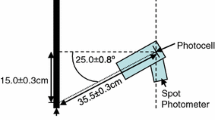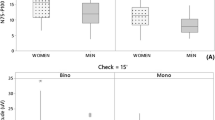Abstract
Purpose
Owing to several factors, peak latencies of pattern-reversal visual evoked potentials (p-VEP) are delayed when viewing liquid crystal display (LCD) monitors compared to those evoked when viewing cathode ray tube (CRT) monitors. However, few studies have examined whether biological factors affect latency in LCD. This study aimed to investigate whether biological factors caused latency changes in LCD among young subjects.
Methods
Twenty-eight subjects (56 eyes) aged 21–29 years (mean ± SD, 22.7 ± 1.7) participated in this study. We recorded output from each eye twice for both CRT and LCD monitors under the same conditions for monocular p-VEP. The peak latencies of three components (N75, P100, and N145) were compared between these two monitors.
Results
All peak latencies recorded with LCD were delayed compared to those recorded with CRT: N75, 9.7 ± 2.5 ms; P100, 10.1 ± 3.0 ms; and N145, 8.4 ± 6.2 ms (all p < 0.001). The degree of latency delay varied depending on the components. Moreover, all peak latencies of CRT appeared earlier than standard values of N75, P100, and N145.
Conclusions
These findings suggest that the following aspects should be considered when assessing biological factors that may affect latency: components might influence latency changes; a young age could be related to an early appearance of peak latencies; inter-individual differences might cause latency change. These biological factors should be considered as possible causes for the varying latencies in an LCD monitor. Further studies should include healthy adults with a wider age range to assess the effects of age on latency.


Similar content being viewed by others
Data availability
The datasets generated and/or analysed during the current study are available from the corresponding author on reasonable request.
References
Kuroiwa Y, Sonoo M (1998) Clinical evoked potentials handbook. Chugai Igakusha, Tokyo
Matsumoto CS, Shinoda K, Matsumoto H, Funada H, Minoda H, Mizota A (2013) Liquid crystal display screens as stimulators for visually evoked potentials: flash effect due to delay in luminance changes. Doc Ophthalmol 127:103–112. https://doi.org/10.1007/s10633-013-9387-9
Nagy BV, Gémesi S, Heller D, Magyar A, Farkas A, Abrahám G, Varsányi B (2011) Comparison of pattern VEP results acquired using CRT and TFT stimulators in the clinical practice. Doc Ophthalmol 122:157–162. https://doi.org/10.1007/s10633-011-9270-5
Husain AM, Hayes S, Young M, Shah D (2009) Visual evoked potentials with CRT and LCD monitors: when newer is not better. Neurology 72:162–164. https://doi.org/10.1212/01.wnl.0000339041.29147.5f
Are the Response Time Figures True? A close look at LCD video performance [EIZOGlobal web site] (May 31, 2010). https://www.eizoglobal.com/library/basics/response_time_figures/. Accessed Apr 12, 2020
Kaltwasser C, Horn FK, Kremers J, Juenemann A (2009) A comparison of the suitability of cathode ray tube (CRT) and liquid crystal display (LCD) monitors as visual stimulators in mfERG diagnostics. Doc Ophthalmol 118:179–189. https://doi.org/10.1007/s10633-008-9152-7
Matsumoto CS, Shinoda K, Matsumoto H, Funada H, Sasaki K, Minoda H, Mizota A (2014) Comparisons of pattern visually evoked potentials elicited by different response time liquid crystal display screens. Ophthalmic Res 51:117–123. https://doi.org/10.1159/000356688
Odom JV, Bach M, Brigell M, Holder GE, McCulloch DL, Tormene AP, Vaegan, (2010) ISCEV standard for clinical visual evoked potentials. Doc Ophthalmol 120:111–119
American Society Clinical Neurophysiology (1994) AEEGS guidelines on evoked potentials: guideline nine: guidelines on evoked potentials. J Clin Neurophysiol 11:40–73
Celesia GG, Daly RF (1977) Effects of aging on visual evoked responses. Arch Neurol 34:403–407. https://doi.org/10.1001/archneur.1977.00500190037005
Kuroiwa Y (1997) Visual evoked potentials. Jpn J Electroencephalogr Electromyogr 25(2):65–66
Odom JV, Bach M, Brigell M, Holder GE, McCulloch DL, Mizota A, Tormene AP (2016) ISCEV standard for clinical visual evoked potentials: (2016 update). Doc Ophthalmol 133:1–9
Thornton AR (2008) Evaluation of a technique to measure latency jitter in event-related potentials. J Neurosci Methods 168:248–255. https://doi.org/10.1016/j.jneumeth.2007.09.031
Tobimatsu S, Celesia GG (2006) Studies of human visual pathophysiology with visual evoked potentials. Clin Neurophysiol 117:1414–1433. https://doi.org/10.1016/j.clinph.2006.01.004
Shigeto H, Tobimatsu S, Yamamoto T, Kobayashi T, Kato M (1998) Visual evoked cortical magnetic responses to checkerboard pattern reversal stimulation: a study on the neural generators of N75, P100 and N145. J Neurol Sci 156:186–194. https://doi.org/10.1016/s0022-510x(98)00026-4
Tobimatsu S (1996) Recent progress of visual evoked potentials. Rinsho-nohha 38:784–790
Abe H, Hasegawa S (1992) Study inter-individual difference among normal subjects. In: Shimoji K (ed) Study on pattern reversal VEP for clinical application. Nishimura Shoten, Tokyo, pp 120–127
Sokol S, Moskowitz A, Towle VL (1981) Age-related changes in the latency of visual evoked potentials. Influence of check size. Electroencephalogr Clin Neurophysiol 51:559–562. https://doi.org/10.1016/0013-4694(81)90232-7
Kuroiwa Y (1992) Normal waveforms and clinical application. In: Shimoji K (ed) Evoked potentials –basic to clinical. Nishimura Shoten, Tokyo, pp 88–119
Acknowledgements
The authors would like to thank the Department of Laboratory Medicine at Shinshu University Hospital. We would also like to express our gratitude towards all the study participants.
Funding
The authors received no specific funding for this work.
Author information
Authors and Affiliations
Contributions
All authors participated in a meaningful way in the preparation of the manuscript. MU designed the study, supervised the collection and interpretation of data, and drafted the manuscript. MM collected and interpreted data. HY interpreted statistical data and created the figures. HM interpreted data and supervised writing the manuscript. All authors read and approved the final manuscript.
Corresponding author
Ethics declarations
Conflict of interest
The authors declare that they have no conflict of interest.
Ethical approval
The research was conducted at the Department of Laboratory Medicine, Shinshu University Hospital. All research procedures were approved by the Ethics Committee of Shinshu University, School of Medicine (2770).
Statement of human rights
All procedures performed in studies involving human participants were in accordance with the ethical standards of the institutional review board of the Shinshu Univerisy and we performed in accordance with the 1964 Helsinki Declaration.
Statement on the welfare of animals
This study does not contain any research on animals.
Informed consent
Informed consent was obtained from all individual participants included in this study.
Consent for publication
All participants signed an informed consent form regarding the publication of their aggregated, anonymized data, preventing identification of individuals.
Additional information
Publisher's Note
Springer Nature remains neutral with regard to jurisdictional claims in published maps and institutional affiliations.
Rights and permissions
About this article
Cite this article
Ura, M., Matsuo, M., Yamazaki, H. et al. Effect of biological factors on latency of pattern-reversal visual evoked potentials associated with cathode ray tubes and liquid crystal display monitors in normal young subjects. Doc Ophthalmol 143, 185–192 (2021). https://doi.org/10.1007/s10633-021-09833-z
Received:
Accepted:
Published:
Issue Date:
DOI: https://doi.org/10.1007/s10633-021-09833-z




